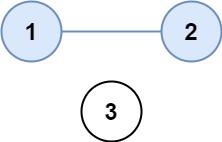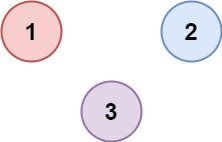Description
There are n cities. Some of them are connected, while some are not. If city a is connected directly with city b, and city b is connected directly with city c, then city a is connected indirectly with city c.
A province is a group of directly or indirectly connected cities and no other cities outside of the group.
You are given an n x n matrix isConnected where isConnected[i][j] = 1 if the ith city and the jth city are directly connected, and isConnected[i][j] = 0 otherwise.
Return the total number of provinces.
Example 1:

Input: isConnected = [[1,1,0],[1,1,0],[0,0,1]] Output: 2
Example 2:

Input: isConnected = [[1,0,0],[0,1,0],[0,0,1]] Output: 3
Constraints:
1 <= n <= 200n == isConnected.lengthn == isConnected[i].lengthisConnected[i][j]is1or0.isConnected[i][i] == 1isConnected[i][j] == isConnected[j][i]
Code
Union and Find
- Union By Rank and Path Compression in Union-Find Algorithm Time Complexity: , Space Complexity:
class Solution {
int res;
unordered_map<int, int> f;
public:
int findCircleNum(vector<vector<int>>& isConnected) {
res = isConnected.size();
for(int i = 0; i < isConnected.size(); i++) {
for(int j = 0; j < isConnected[i].size(); j++) {
if(isConnected[i][j] == 1) {
uni(i, j);
}
}
}
return res;
}
int find(int x) {
if(!f.count(x)) {
f[x] = x;
}
if(f[x] != x) {
f[x] = find(f[x]);
}
return f[x];
}
void uni(int x, int y) {
x = find(x), y = find(y);
if(x != y) {
res--;
f[x] = y;
}
}
};